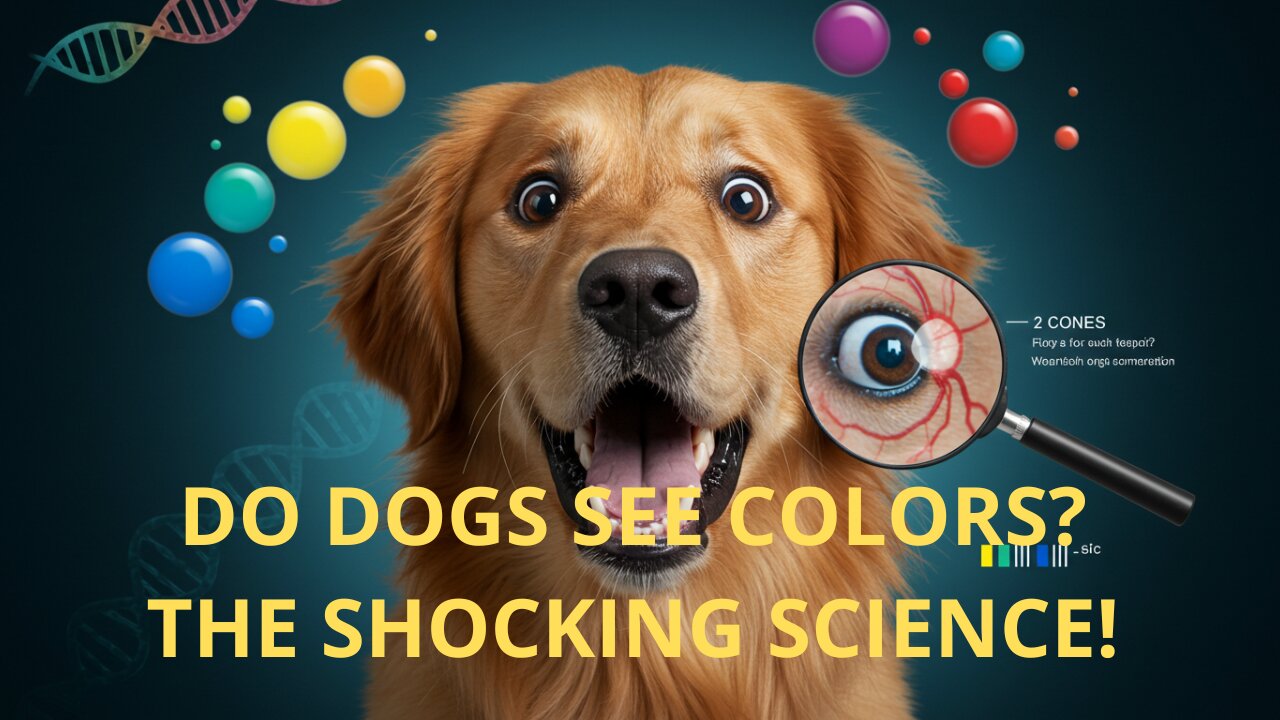Premium Only Content

Do Dogs Really See in Black and White? Science Has the Answer!
Do Dogs Really See in Black and White? Science Has the Answer!
A Myth That Has Stood the Test of Time
For decades, a popular belief has circulated in conversations, books, and even TV shows the idea that our loyal canine companions see the world only in shades of black, white, and gray. This notion became so widespread that many people simply accepted it as an unquestionable truth. After all, if everyone says the same thing, it must be true, right? Wrong!
The truth about how dogs see the world is far more fascinating and colorful than that oversimplified version passed down through the years. Thanks to advances in veterinary science, biology, and comparative ophthalmology, we now know exactly how dogs perceive their surroundings. And the answer may surprise many pet owners who have always imagined their furry friends living in a colorless world.
In this article, we’ll dive deep into the canine visual universe exploring not only whether dogs can see colors, but also how the canine eye works, which colors they can distinguish, why their vision differs from ours, and how these differences influence their behavior and interaction with the environment.
Get ready to discover that a dog’s vision is far richer and more complex than you ever imagined!
The Origin of the Myth: Why Did We Think Dogs Saw in Black and White?
To understand how this myth took root, we need to go back in time. In the early 20th century, scientists had very limited knowledge of animal eye anatomy. The first studies on animal vision were rudimentary often based on assumptions and superficial observations, without the support of the advanced technology we have today.
One of the main reasons behind this mistaken belief was a direct, oversimplified comparison with human vision. Researchers at the time noticed that dogs didn’t respond to colors the same way humans did, leading to the premature conclusion that they simply couldn’t see colors at all. It was an all-or-nothing interpretation: either they saw the full color spectrum like us or none at all.
Adding to that, dogs didn’t show much interest in colorful objects, unlike some other animals, which reinforced the theory. In basic experiments, dogs seemed to rely more on other senses like smell and hearing than on color vision.
Another factor that helped keep the myth alive was the slow spread of scientific communication. When more detailed studies eventually started to reveal the truth about canine vision, the information took decades to reach the public. Meanwhile, books, encyclopedias, and educational programs continued to repeat outdated and incorrect information.
Popular media also played a big part. Movies, cartoons, and TV shows often portrayed a dog’s perspective in black and white, visually reinforcing the myth. Although artistically effective, this representation was scientifically inaccurate yet so common that it became ingrained in people’s minds as fact.
The Anatomy of a Dog’s Eye: Understanding the Structure
To truly grasp how dogs see, we first need to understand the basic anatomy of the canine eye and how it differs from the human eye. Like ours, a dog’s eyes are incredibly complex organs that evolved over millions of years to meet the species’ specific survival needs.
The basic structure of a dog’s eye includes the cornea (the transparent outer layer), the iris (the colored part that controls how much light enters), the pupil (the opening in the center of the iris), the lens (which focuses light), and the retina (where images are formed and signals are sent to the brain through the optic nerve).
The retina is especially important when it comes to color vision. It contains two main types of light-sensitive cells: rods and cones.
Rods are responsible for vision in low light and detecting movement.
Cones handle color perception and detailed vision under bright light.
Here’s where it gets interesting:
Humans have three types of cones in their retinas, each sensitive to different wavelengths of light red, green, and blue. This system, called trichromatic vision, allows us to see a wide spectrum of millions of colors.
Dogs, however, have only two types of cones
one sensitive to blue-violet light and another to yellow-green light. That means they have what’s known as dichromatic vision, similar to red-green color blindness in humans.
This is the key to understanding how dogs actually perceive colors in the world around them.
In addition, dogs have a much higher ratio of rods to cones than humans. While this limits their ability to see bright, vivid colors, it gives them major advantages in other visual areas which we’ll explore next.
The Truth Revealed: Yes, Dogs See Colors!
Now for the ultimate answer to our main question: No, dogs do not see the world only in black and white!
They definitely see colors just not in the same way we do.
Dogs’ dichromatic vision allows them to distinguish certain colors, but within a more limited range. Rigorous scientific studies including behavioral tests and anatomical analyses of canine retinas have confirmed that dogs can perceive and tell apart specific colors.
The colors they see best are blue and yellow. They can clearly differentiate between shades of these colors. For example, a dog can easily tell the difference between a bright blue ball and a bright yellow one those colors appear vibrant and distinct to them.
On the other hand, colors in the red, orange, and green range are harder for dogs to distinguish.
Red may appear as a brownish-yellow or dark grayish tone.
Green may look pale yellowish or off-white.
So, that bright red toy you bought thinking it would stand out in the green grass? To your dog, it might actually blend right in. A blue toy, however, would pop out clearly and be much easier to find.
Scientists discovered this through various experiments. One famous study trained dogs to choose between colored panels to receive treats. The dogs consistently distinguished blue and yellow but struggled with red and green.
More recent tests using electroretinography which measures electrical responses in the retina to different wavelengths of light confirmed that dogs’ cones respond primarily to blue-violet and yellow-green light.
Comparing Vision: Humans vs. Dogs
To truly appreciate how dogs see the world, it helps to make a direct comparison between human and canine vision. Let’s break down the main differences and similarities between the two.
Color Perception
As we’ve discussed, humans have trichromatic vision three types of cones that let us see about 10 million different colors.
Dogs, on the other hand, are dichromatic, which limits them to roughly 10,000 color variations.
While that might sound like a huge difference, remember 10,000 colors are still far more than just black and white! Their world isn’t dull or gray; it’s just painted in a different palette.
Visual Acuity
Humans generally have sharper eyesight than dogs.
A person with 20/20 vision can see details clearly at about 6 meters (20 feet).
A dog would need to be around 1.5 meters (5 feet) from the same object to see it as clearly.
That means dogs are more nearsighted than humans, with an estimated visual range of 20/75.
Night Vision
This is where dogs really shine!
Remember the high number of rods in their retinas? That gives them superior night vision.
Dogs also have a special reflective layer behind the retina called the tapetum lucidum. It acts like a mirror, bouncing light back through the photoreceptors and enhancing low-light vision.
That’s why a dog’s eyes often glow in the dark when light hits them it’s the tapetum reflecting the light back.
This adaptation allows dogs to see in lighting conditions that would be almost pitch-black for us.
Motion Detection
Dogs are exceptionally good at detecting movement much better than humans.
They can notice even slight motion from far away, which is why they’ll spot a squirrel long before you do.
A dog can detect movement at distances up to 900 meters (almost half a mile)!
This is an evolutionary advantage inherited from their wolf ancestors, who needed to spot prey or threats quickly.
Field of Vision
Dogs also have a wider field of view than humans.
While our field of vision covers about 180 degrees, a dog’s can reach up to 250 degrees, depending on the breed and the position of the eyes.
This gives them excellent peripheral vision, which is useful for spotting approaching animals or objects from the sides.
Depth Perception
However, because dogs’ eyes are positioned more to the sides of their heads, they have slightly less depth perception than humans.
Their binocular overlap the area where both eyes’ fields of vision intersect is smaller, which affects their 3D perception somewhat.
Still, for a species that relies more on smell, hearing, and motion than fine visual details, this trade-off makes perfect evolutionary sense.
Practical Implications: How Vision Affects Your Dog’s Daily Life
Understanding how dogs actually see isn’t just a fun science fact it has real, practical applications in how we care for and interact with them.
Choosing Toys
Now that you know dogs see blue and yellow best, you can make smarter choices when buying toys.
That bright red ball might look great to you, but a blue one will stand out far more clearly for your dog, especially in the grass.
Training and Visual Cues
If you use colored markers or cones during training, go for blue or yellow instead of red or green.
Your dog will recognize them more easily.
Home Environment
When setting up your dog’s space at home, think about visual contrast.
A blue bed on a light-colored floor will be easier for your dog to find than a red one that blends in.
Fetch and Search Games
If you play fetch outside, avoid using red or orange toys in grassy areas they’ll be much harder for your dog to spot.
Stick to blue or yellow items instead.
Communication and Visibility
While dogs rely heavily on body language, color contrast can help them recognize you more easily.
If you wear clothing that contrasts well within their visible range like blue or yellow you’ll stand out more clearly to your dog, even from a distance.
Safety at Night
Even though dogs see well in low light, reflective collars and harnesses are still important for safety.
Choosing accessories in blue tones can also make it easier for dogs to identify each other in dim lighting.
Environmental Enrichment
When creating a stimulating environment for your dog, think beyond colors use textures, shapes, and light contrasts.
Since dogs have limited color perception, they enjoy variety in other visual and sensory elements.
The Evolution of Canine Vision: Why Dogs See the Way They Do
To truly understand how dogs see the world, it helps to look at why their vision evolved this way. The answer lies deep in the evolutionary history of canines and the survival needs of their ancestors.
The ancestors of modern dogs were crepuscular predators most active at dawn and dusk. During those low-light hours, the ability to detect movement and see in dim conditions was far more important than distinguishing a wide range of colors.
That’s why dogs evolved to have many more rods than cones in their retinas.
Rods enhance night vision and motion detection, while cones handle color.
For early canines, being able to spot prey moving in the shadows meant survival while the exact color of the prey was irrelevant.
So, dogs’ dichromatic vision isn’t a weakness it’s an evolutionary advantage perfectly suited to their environment.
Their wide field of view is another key adaptation.
Their wide field of view is another key adaptation.
Being able to see more of their surroundings without turning their heads helped them hunt effectively and stay alert for predators.
This feature is especially strong in long-snouted breeds, whose eyes sit farther apart on their heads.
When we compare dogs to other animals, we see fascinating patterns:
Daytime animals, like primates and many birds, rely heavily on color to find food and recognize mates so they developed trichromatic or even tetrachromatic vision (seeing 4 color channels).
Nocturnal or crepuscular mammals, like dogs, cats, and rodents, evolved dichromatic vision, prioritizing movement and light sensitivity instead.
Interestingly, wolves dogs’ closest wild relatives have nearly identical visual systems.
That makes sense, since domestication happened relatively recently (around 15,000–40,000 years ago) not long enough, evolutionarily speaking, for major visual changes to occur.
Some scientists even believe that dichromatic vision may offer specific advantages.
For example, animals that see fewer colors can sometimes see through camouflage more easily, since they aren’t distracted by color variations that hide prey in green or red environments.
In other words, dogs might actually spot hidden animals better than we can.
Breed Variations: Do All Dogs See the Same Way?
A common question is whether different dog breeds see the world differently.
The short answer: mostly yes but with a few interesting differences related to anatomy.
All dog breeds share the same two-cone retinal structure, so their color perception is identical a Chihuahua and a Saint Bernard both see the same color range.
However, physical features can influence other aspects of vision:
Eye Position
Breeds with longer snouts (like Greyhounds and Collies) have eyes set more toward the sides of their heads.
This gives them a wider field of view up to 270 degrees in some cases but slightly reduces depth perception because there’s less binocular overlap.
Breeds with shorter snouts (like Pugs and Bulldogs) have eyes placed more toward the front, like humans.
That means better depth perception, but a narrower field of vision.
Eye Size and Shape
Dogs with larger eyes may gather more light, which can help them see better in dim conditions.
However, breeds with very prominent eyes like Pugs are also more prone to eye injuries and health issues.
Visual Sharpness
Some research suggests that breeds developed for sight-based work, like hunting or herding dogs, may have slightly sharper vision than companion breeds.
Still, these differences are minor and don’t affect their color perception.
Health Differences
Certain breeds are more susceptible to specific eye problems that can affect vision.
For instance:
Brachycephalic breeds (short-snouted) often suffer from corneal ulcers due to eye exposure.
Collies can develop a hereditary condition called Collie Eye Anomaly, which impairs retinal function.
Despite these differences, all dogs share the same basic color vision system they just experience variations in field width, depth perception, and overall visual clarity.
Testing Your Dog’s Vision: Simple At-Home Experiments
If you’re curious to see how your dog responds to different colors, there are a few fun, simple experiments you can try at home.
They’re not scientific tests, of course, but they can give you a glimpse into how your dog perceives the world.
Experiment 1: The Color Toy Test
Line up three or four identical toys that only differ in color one blue, one yellow, one red, and one green.
Place them on the grass or another neutral surface. Ask your dog to fetch one, and note which color he goes for first.
Repeat several times, changing the positions.
You’ll probably notice your dog finds the blue and yellow toys faster than the red and green ones.
Experiment 2: Color Hide-and-Seek
Take two identical toys, but in different colors (ideally blue and red).
Hide them in similar spots for example, the red one in green grass and the blue one on a gray concrete floor.
Watch which one your dog locates first.
This can show how color contrast affects visibility for dogs.
Experiment 3: The Bowl Choice Test
Use three identical bowls turned upside down one blue, one yellow, and one red.
Hide a treat under one of them and let your dog find it.
After a few rounds, switch the positions and observe whether your dog tends to choose a certain color more often or finds treats faster under specific colors.
Experiment 4: Outdoor Observation
While walking your dog, pay attention to how he reacts to different colored objects.
Does he notice blue cars faster than red ones?
Does he chase a yellow ball more eagerly than an orange one?
Casual observations like these can reveal a lot about his visual preferences and capabilities.
Important: Remember, dogs rely heavily on their sense of smell far more than on vision.
Even in these tests, your dog might be using scent cues rather than sight.
To minimize that, try using new or freshly washed toys with minimal odor.
These experiments are mainly for fun and bonding, not diagnosis.
If you ever suspect your dog has real vision problems, it’s best to consult a veterinary ophthalmologist.
Other Fascinating Aspects of Canine Vision
Dogs’ vision is intriguing not just because of color perception there are many other remarkable aspects to how their eyes work.
Flicker Fusion Rate
Dogs have a higher flicker fusion rate than humans.
That means they can detect flickering light at much higher speeds.
While humans perceive a steady image on a TV screen at 60 Hz, dogs can detect flickering up to 70–80 Hz.
This means older tube TVs may have looked like flashing lights to dogs!
Luckily, modern screens (LED, LCD, OLED) refresh fast enough to appear smooth for both humans and dogs.
Peripheral vs. Central Vision
Dogs have excellent peripheral vision, but their central (foveal) vision isn’t as sharp as ours.
Humans have a dense concentration of cones in an area called the fovea, giving us crystal-clear central vision.
Dogs have a less developed version of this area, which contributes to their lower visual acuity overall.
Contrast Sensitivity
Dogs are very sensitive to differences in brightness and contrast, which helps them recognize shapes and movements even when colors are hard to distinguish.
Combined with their exceptional motion detection, this makes dogs great at spotting moving objects even far away.
Light Adaptation
A dog’s eyes adapt quickly to changes in light conditions.
Their pupils dilate and contract rapidly, and the tapetum lucidum enhances brightness in low-light settings.
This quick adaptation was vital for their ancestors, who often hunted at dawn or dusk when light levels changed rapidly.
Underwater Vision
Although not as developed as in aquatic animals, some dogs can see reasonably well underwater.
Breeds bred for water work, like Retrievers, may have mild adaptations that improve this ability.
Still, water naturally blurs vision for all land mammals because of how light bends differently through air and water.
Visual Memory
Studies show dogs have a strong visual memory, especially when combined with smell and sound.
They can recognize familiar people, places, and objects they’ve seen before although they often rely on smell to confirm what they’re seeing.
Common Myths About Dog Vision: Separating Fact from Fiction
Beyond the famous black-and-white myth, there are several other misconceptions about how dogs see the world. Let’s clear them up one by one.
Myth 1: “Dogs Can’t See TV.”
False!
Dogs absolutely can see television especially modern high-refresh-rate screens.
Many dogs enjoy watching shows that feature other animals, particularly when the sounds catch their attention.
There are even TV channels made specifically for dogs, designed with their color range, motion detection, and audio sensitivity in mind.
Myth 2: “Dogs Are Completely Blind in the Dark.”
False!
Dogs have outstanding night vision thanks to their high number of rods and their reflective tapetum lucidum layer.
However, they still need at least a little light to see.
In total darkness, with no light at all, they can’t see just like us.
The difference is, they need much less light than humans to see reasonably well.
Myth 3: “Vision Is a Dog’s Most Important Sense.”
False.
For dogs, smell is by far their most dominant sense, followed by hearing.
Vision plays an important role, but it’s third in their sensory hierarchy.
Dogs often “trust” their noses and ears more than their eyes.
Myth 4: “Dogs Can’t Recognize Human Faces Visually.”
False again!
Research has shown that dogs can recognize familiar human faces, even in photographs.
They have specialized regions in their brains for processing faces similar, though not identical, to those found in humans.
Myth 5: “Small Dogs See Better Than Large Dogs.”
There’s no solid scientific evidence for this.
A dog’s size doesn’t directly affect its visual quality, although eye placement and structure can vary between breeds, influencing field of view or depth perception slightly.
Myth 6: “All Old Dogs Go Blind.”
Not necessarily.
While eye problems like cataracts are more common in senior dogs, many maintain functional vision throughout life especially with proper veterinary care and nutrition.
Caring for Your Dog’s Eye Health
Understanding how dogs see also helps us recognize when something might be wrong.
Here are some key points to watch for.
Signs of Vision Problems
Bumping into objects, especially in unfamiliar places
Reluctance to climb stairs or jump onto furniture
Behavioral changes like anxiety or irritability
Redness, swelling, or excessive tearing in the eyes
Cloudiness or color changes in the eyes
Unequal pupil sizes
Increased sensitivity to light
Unusual eye movement or crossing
Common Eye Conditions
Cataracts: Clouding of the lens that can cause blindness; common in older dogs and some breeds.
Glaucoma: Painful increase in eye pressure that can lead to vision loss.
Progressive Retinal Atrophy (PRA): Gradual retinal degeneration leading to blindness.
Dry Eye (Keratoconjunctivitis Sicca): Inadequate tear production.
Corneal Ulcers: Painful injuries on the eye’s surface that require immediate care.
Preventive Care Tips
Schedule regular veterinary exams, including eye checks
Keep the area around the eyes clean and free from excess hair
Protect your dog’s eyes during activities that could cause injury
Provide proper nutrition, including antioxidants for eye health
Avoid excessive exposure to bright sunlight yes, some dogs benefit from eye protection in extreme light conditions
Helping Dogs with Vision Loss
If your dog does develop partial or complete blindness, don’t worry dogs are incredibly adaptable.
Their other senses are so sharp that they can still live happily and safely with a few adjustments:
Keep furniture and objects in consistent places
Use different textures (like rugs) to mark areas of the house
Add sound or scent cues to help with navigation
Always use a leash in new environments
Be patient, supportive, and offer plenty of encouragement
Conclusion: Appreciating Your Dog’s Unique Perspective
We’ve reached the end of our deep dive into the fascinating world of canine vision.
And now we can answer, once and for all, the question:
Do dogs see in black and white?
The answer is a resounding NO!
Dogs do see colors just not the same way we do.
Their dichromatic vision, focused mainly on blue and yellow, is perfectly adapted to their evolutionary needs and lifestyle.
While they may not experience the same vibrant rainbow of hues that humans do, their world is far from dull or colorless.
More importantly, we’ve learned that dog vision is about much more than color.
Dogs have:
Superior night vision, thanks to more rods and the tapetum lucidum
Extraordinary motion detection, honed by evolution
A wider field of view, ideal for spotting movement from all directions
Rapid light adaptation, allowing them to thrive from dawn to dusk
Each of these traits tells a story a story about evolution, survival, and the bond between species that began thousands of years ago.
Understanding how dogs see the world isn’t just scientifically fascinating it’s practically useful too.
It helps us choose better toys, train more effectively, design safer environments, and connect more deeply with our four-legged friends.
When we see through their eyes even just a little we appreciate them on a whole new level.
Because while dogs might not see the same colors we do, they see something far more meaningful:
They see us their companions, protectors, and family in every shade that truly matters.
-
 LIVE
LIVE
Robert Gouveia
1 hour agoEx-CIA Brennan's Criminal Referral!! Jack Smith Caught AGAIN! Judge BLOCKS ICE Arrests!
1,274 watching -
 14:51
14:51
Rethinking the Dollar
7 hours agoSilver Price Crash? Why You’re Still Paying $60+ for Eagles
4.82K7 -
 LIVE
LIVE
The Amber May Show
2 hours agoSlacker82Alpha| SPECIAL GUEST RENOWNED UFO EXPERT STAN DEYO
61 watching -
 LIVE
LIVE
MattMorseTV
3 hours ago $5.32 earned🔴Community Hangout🔴
437 watching -
 LIVE
LIVE
Tundra Tactical
4 hours ago $2.52 earnedThe Great Tundra Nation Gaming Stream!!! Featuring ThePiggNation LAST DAY!!!!
99 watching -
 2:38:50
2:38:50
The Rabble Wrangler
4 hours agoThe Best in the West | Live From Rumble Studios
23.8K -
 16:55
16:55
Bearing
10 hours agoHasan Piker’s EPIC MELTDOWN 💥 F**k My Audience, F**k Streaming, F**k Socialism 🤬
14.6K21 -
 LIVE
LIVE
LFA TV
19 hours agoLIVE & BREAKING NEWS! | TUESDAY 10/21/25
812 watching -
 1:08:55
1:08:55
vivafrei
1 day agoExposing the Trans MADNESS in Maine School Boards! Live with Activist and Truth Teller "Corn Pop"!
116K26 -
 1:50:18
1:50:18
The Quartering
5 hours agoWhat The Heck Is Even Happening?
116K26